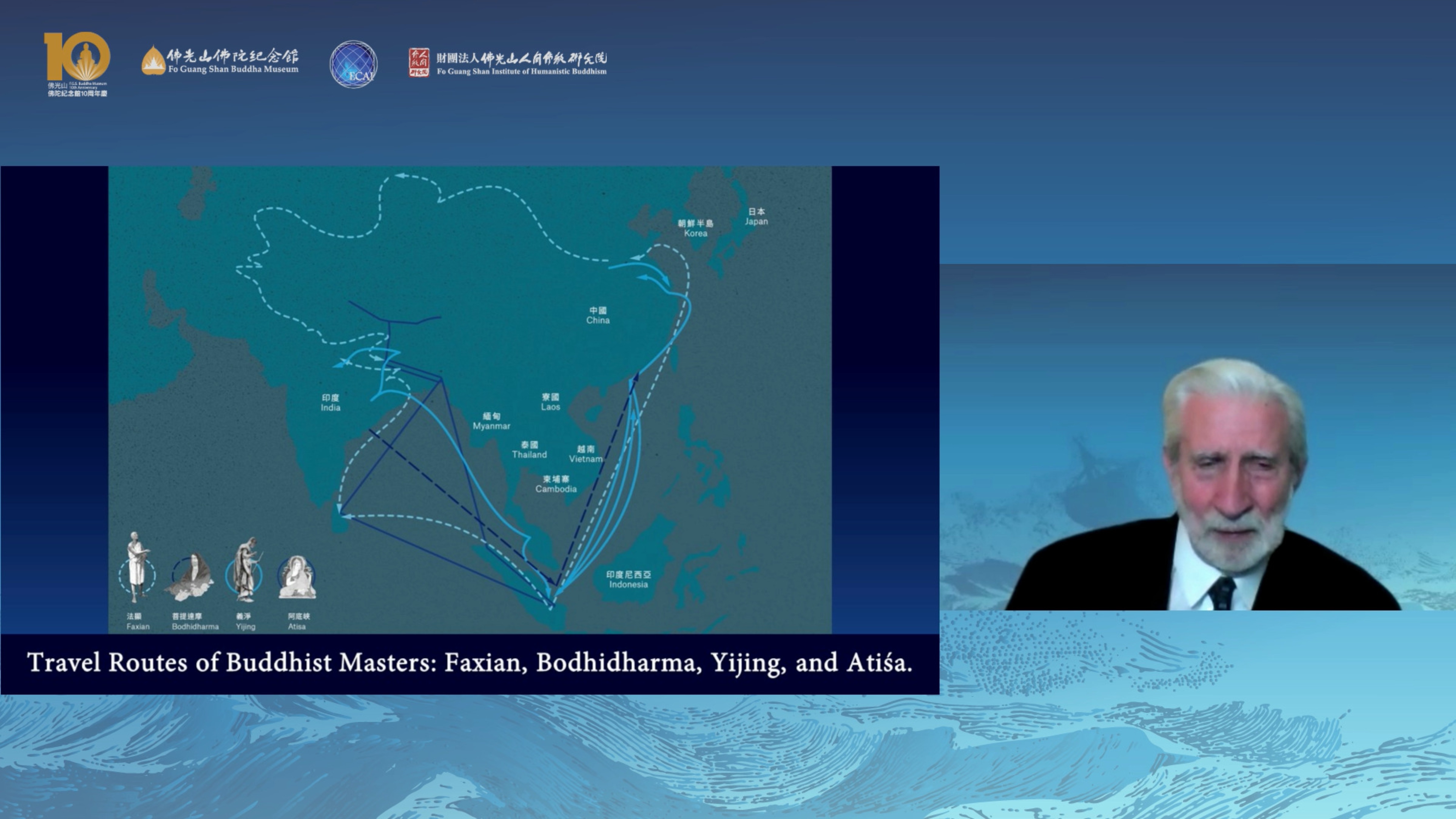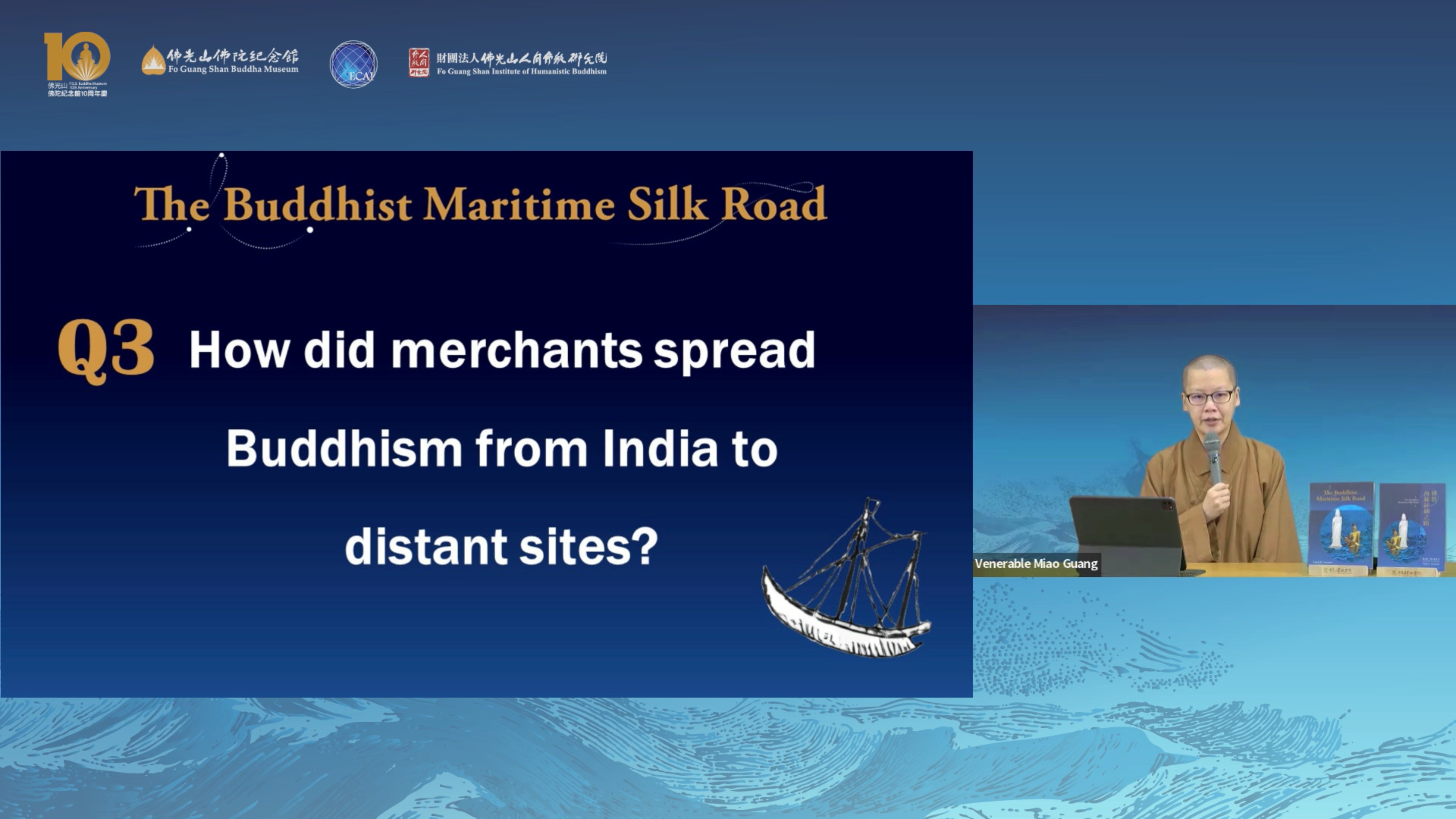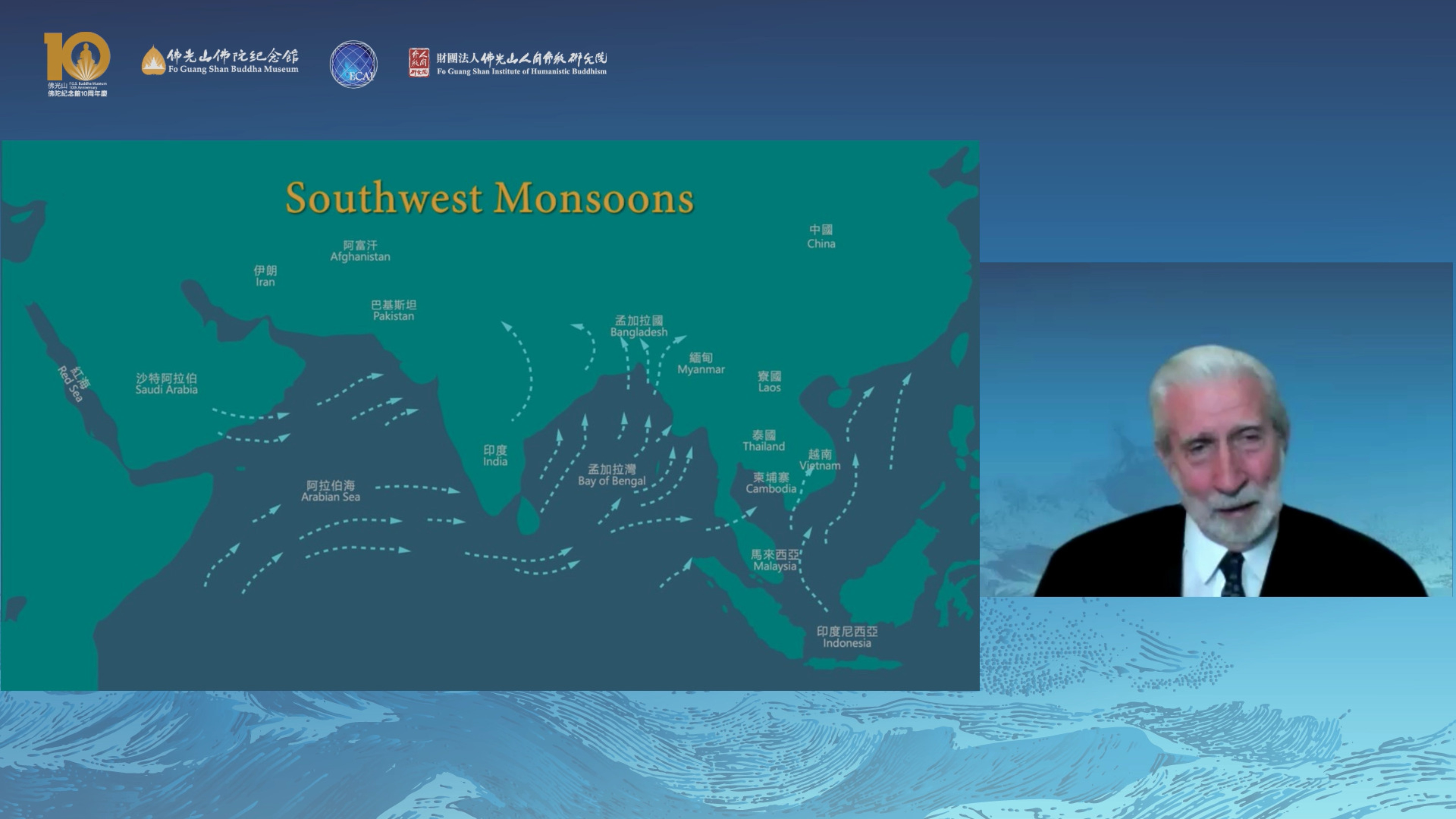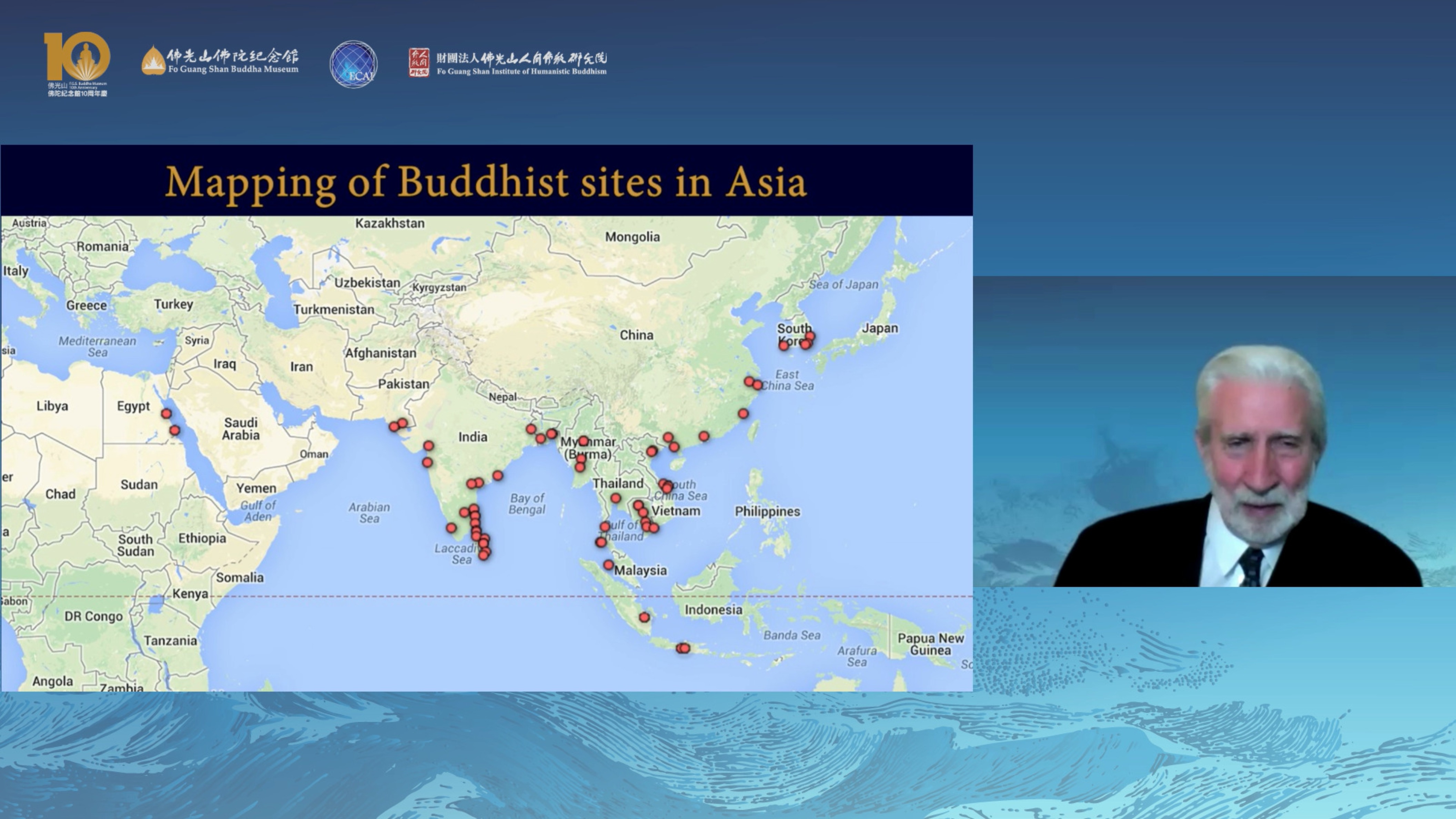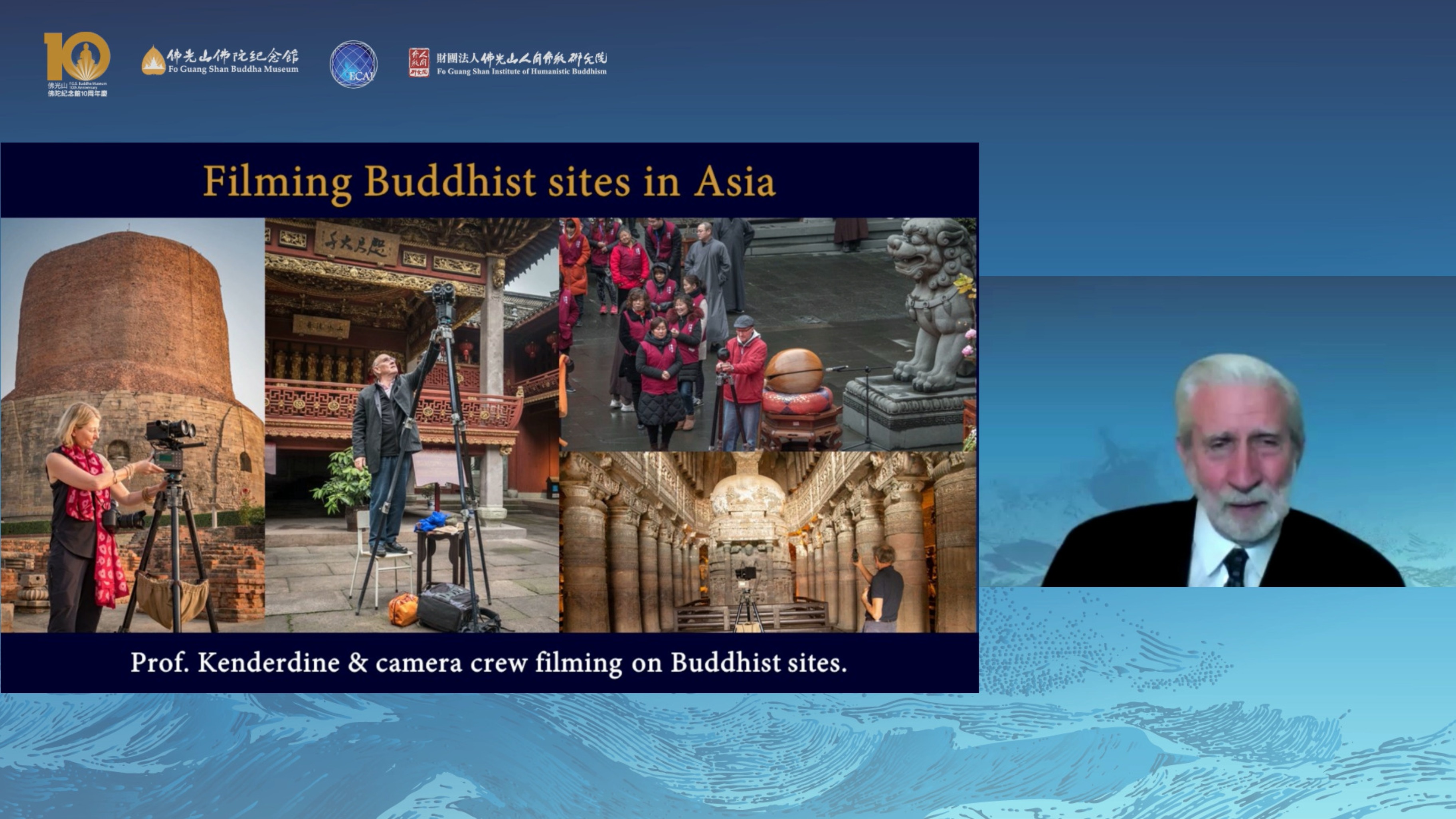On July 17 and 18, The Buddhist Maritime Silk Road Online Book Launch was held to celebrate the publication of the book, which is based on Dr. Lewis R. Lancaster’s study on Maritime Buddhism which lasted for decades. Venerable Miao Guang, Vice Chancellor of the Fo Guang Shan Institute of Humanistic Buddhism, hosted the session and interviewed the author.
The book serves as an accompaniment to the “Buddhist Maritime Silk Road—New Media Art Exhibition” at the Fo Guang Shan Buddha Museum. Dr. Lancaster, Emeritus Professor of UC Berkeley and Director of Electronic Cultural Atlas Initiative (ECAI) collaborated with three other curators, namely Professors Sarah Kenderdine (École polytechnique fédérale de Lausanne, Switzerland), Jeffrey Shaw (Hong Kong Baptist University), both pioneers in new media art, and Venerable Ru Chang (Director of the Buddha Museum) for this 5-year exhibition.
The book launch session provided ground-breaking views on the history of Buddhist dissemination as well as new inspirations for the development of Buddhism in the twenty-first century. The following is summary of the interview:
What initiates the study of Buddhist Maritime Silk Road?
Dr. Lancaster discovered that Buddhism in India was indeed a coastal tradition after identifying archaeological issues related to Buddhism during an ECAI meeting in South India. Being taught that there was no Buddhism in Southern India as a student, field notes from Archaeological Survey of India (ASI) office show the region filled with Buddhist sites inspired him to research on Buddhist Maritime Silk Road.
What is the connection between the maritime and the caravan Silk Roads?
The caravan land route was once a major means of transportation for trade, but it has since been replaced by the sea route. As trade evolved, so did the way Buddhism was disseminated. However, in the past, the equally-important sea route for the spread of Buddhism received far less attention.
What was the role of merchants in the spread of Buddhism?
Merchants had to spend long periods of time away from their homeland waiting for monsoon winds to change. As a result, they often had two homes, one in their homeland and another in the port abroad. The Buddhist merchants brought monastics with them as religious support, and were happy that this new Buddhist tradition was spreading outside of India. Including Buddhism as part of the heritage of the new port was a way to create a cultural environment in the new place. On the other hand, to travel long distances, Buddhist monks and nuns had to rely on merchants for their guides and support – only merchants and occasional envoys or explorers traveled long distances.
What is the importance of Buddhism in the South that entered through Guangzhou, China?
Buddhist masters, ideas, and practices that are influential in Chinese Buddhism today mostly entered from the port in Guangzhou, including Bodhidharma (the first patriarch of Chan Buddhism), yogacara texts, the Guanyin tradition, and the bhikṣuṇī ordination. In short, Buddhism in China and Taiwan today has its major features from the maritime world rather than the caravans.
What was the greatest challenge of this study?
Since written records for the early years are missing, new data is needed to support Dr. Lancaster’s argument about the presence of Buddhism in the world of seaports and sea trades. Dr. Lancaster sent teams of young archaeologists equipped with GPS, cameras, and computers to all the sites with Buddhist remains identified by the Archaeological Survey of India. The teams were asked to map the sites very precisely. Sometimes, the archaeological dig was just a glass bead – the team had to figure out ways to make data for the study.
Viewers’ comments and reflections:
Belinda Hsueh - BLIA YAD Queensland, Australia
It was fascinating hearing from Dr. Lewis Lancaster share with us the means as to how Buddhism was spread from India to far distant sites along the sea route, talking about a system of systems and how all kinds of people were involved. Despite people coming from different backgrounds and speaking different languages, it is truly amazing they were all connected back to the same route of spreading Buddhism, all of which make us one.
Christine Khanbijian - Three Acts of Goodness (TAG) Dharma School teacher, Hsi Lai Temple, USA
I, like many, assumed that the spread of Buddhism from India to eastern Asia was primarily through routes on land, but I never could have imagined the tremendous influence that sea trade had in spreading the Dharma. One thing I found fascinating was the concept of the “Great Circle” and how a system of systems developed to spread Buddhist ideas across diverse cultures and languages. The example of the mandala was also fascinating, bearing the idea that different traditions arise in different localities, though still with the same root, which is the original teachings of the Buddha. I really enjoyed learning about this fascinating history, especially because it gave me such a different perspective on the silk road and the spread of the Dharma throughout Asia.
Julian Galvin - Preparatory Committee, BLIA Satva Subchapter cum FGDB Translation Team member, Hong Kong
When I first saw the map depicting the expansion of Buddhism over the world, I immediately thought of Mount Sumeru and Jambudvīpa, therefore I too immediately recognized this as a mandala. I viewed Dr. Lancaster’s work and that of the other members of the project team as “Humanistic Buddhist archaeologists exploring the past and providing a crucial new perspective to our comprehension of both ‘the spread of Buddhism’ and the ‘lives and times of individuals who brought the Dharma to far-off lands.’” This is a very valuable tool that will keep the Buddha-Dharma alive for people to hear in this predetermined age of declining Dharma.
Book Launch on Youtube
Paperback Edition:
Fo Guang Cultural Enterprise Co., Ltd.
Online Edition:
Exhibition Info
The Buddhist Maritime Silk Road—New Media Art Exhibition is currently held at Fo Guang Shan Buddha Museum (Gallery 3) from May 2021 until May 2026.












